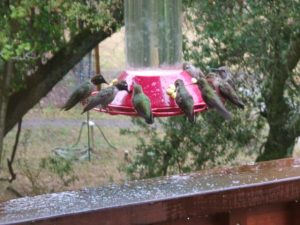Hummingbirds are often likened to “flying flowers,” however it takes a sometimes hard-to-find 1000-2000 nectar-rich flowers plus numerous tiny insects daily to keep a hummingbird aloft. How gardeners plant their yards can help keep our bees and hummingbirds nourished and fit.
Found only in the Western Hemisphere, hummers consume the nectar of many California native plants including manzanita, buckeye, sage, and penstemon. Native plants also support more native insects, essential for wildlife food.
In Tuolumne County, Anna’s hummers can be found year round with Rufous mostly during spring and fall migration. Many Black-chinned hummers are also found in Sonora gardens with Costa’s and Calliopes occasionally sighted.
In some cases, hummingbird range has been extended, probably due to artificial nectar feeders (a boon during tough times if kept scrupulously clean and replenished). At the same time habitat destruction has reduced native plant resources. Pesticides are also a danger. Many pesticides either kill plants outright or enter the nectar, imperiling the birds and killing the small insects that hummers and their nestlings depend on for protein.
Neonicotinoid pesticides (based on an artificial type of nicotine) are systemics that spread throughout plant tissues, potentially exposing insects, hummingbirds and other creatures that consume these plants. The Xerces Society (Xerces.org) points out that most neonicotinoids, or neonics, are long-lived and persist in plant tissue for months or even years. Neonic residue in the soil can be taken up by new plants as well.
Gardeners can be a hummingbird’s friend by planting nectar-rich pesticide-free plants. Nasturtium, larkspur, tithonia (Mexican sunflower), Impatiens balfouri (poor man’s orchid) and cleome (spider flower) are long blooming nectar-producing annuals. To create a true hummingbird haven, also grow several of the following trees, shrubs, and perennials. Aim for a wide variety of flowers over a long period including early and late bloomers. Check Sunset Western Garden Book (SWGB) for cold tolerances and growing conditions.
- Abutilon (flowering maple)
- -Agapanthus (lily of the Nile)
- -Albezia julibrissin (silk tree)
- -Agastache (hummingbird mint or hyssop)
- -Aquilegia (columbine)
- -Actostaphylos (manzanita)
- Buddleia (butterfly bush)
- Callistemon (bottle brush)
- -Campsis (trumpet vine)
- Ceratostigma plumba-ginoides (trailing plumbago)
- -Chilopsis linearis (desert willow)
- Digitalis (foxglove)
- Echeveria (hen and chicks)
- Epilobium (Zauchnaria or California fuchsia)
- Escallonia
- Grevillea ‘Noellii’
- Heuchera (coral bells)
- Hibiscus syriacus (Rose of Sharon)
- Kniphofia (red hot poker)
- Lonicera (honeysuckle)
- Monarda (bee balm)
- Nicotiana glauca (tree tobacco)
- Penstemon
- Phygelius (cape fuchsia)
- Physostegia virginiana (obedient plant)
- Ribes (wild currents and gooseberries)
- **Salvia (sage)
- Stachys albotomentosa and S. coccinea (hedge nettle)
- Verbena bonariensis
- Vitex agnus-castus (chaste tree)
- Weigela
**Salvias to try are: S. clevlandii, greggii, elegans (pineapple sage, very frost sensitive) guaranitica (beautiful blue flowers), involucrata, leucantha (Mexican bush sage), spathacea (hummingbird sage) and sclarea.
To be a true hummingbird friend, encourage your nursery to sell plants that have not been treated with neonicotinoids. Be sure that you too avoid products using neonics. The Center for Food Safety has assembled a lengthy list of pesticide products that contain neonicotinoids. http://www.centerforfoodsafety.org/files/pesticide_list_final_59620.pdf
Vera Strader has planted to support hummingbirds and other pollinators for over forty years. She is a University of California Cooperative Extension Master Gardener of Tuolumne County.


